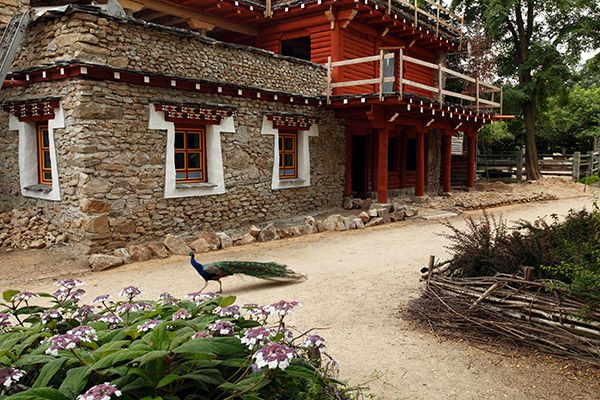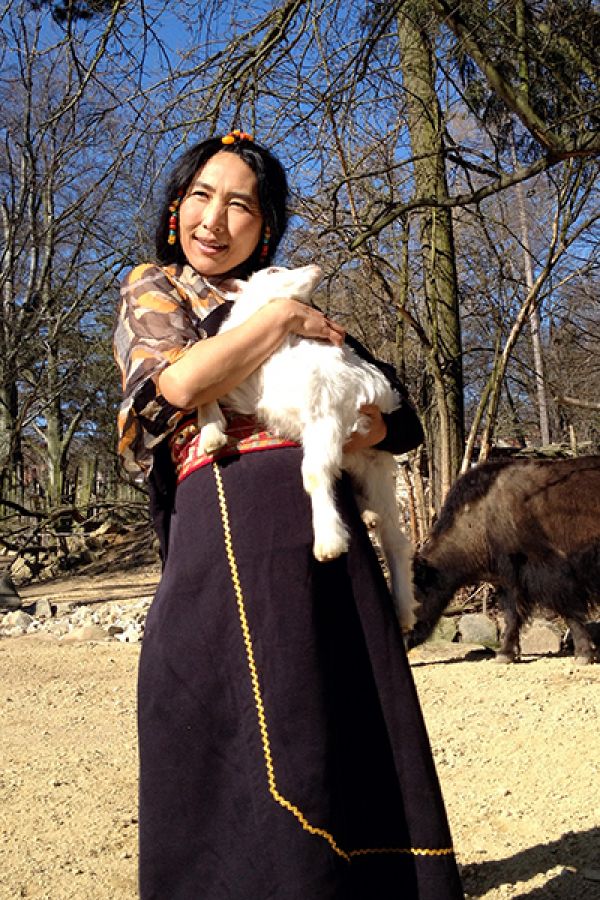
Im Hinblick auf die Tierhaltung herrschen im Naturschutz-Tierpark Görlitz zwei wesentliche geografische Schwerpunkte vor: Europa und Zentralasien. Mit dem Oberlausitzer Bauernhof bestand für unsere europäischen Haustiere schon länger eine zusammenfassende, authentische und lebensnahe Anlage. Um auch unsere asiatischen Haustiere nicht in Einzelhäusern und -gehegen zu präsentieren, wurde 2005 der Grundstein für das Tibet-Dorf gelegt. Ende 2006 wurde das Baugrundstück von einem tibetischen Mönch geweiht.
Um die Lebensbedingungen der Tiere und der tibetischen Bauern möglichst detailgetreu abzubilden, sind einige unserer Mitarbeiter mehrfach nach Tibet auf das Dach der Welt gereist. Sie haben vor Ort mit den Menschen geredet und gelebt, fotografiert, vermessen, Arbeitern beim Bau von Gebäuden über die Schulter geschaut und bei der täglichen Arbeit geholfen. Gerne wollen wir diese Erfahrung mit Herz und Verstand an unsere Besucher weitergeben, damit sie eine Vorstellung über und vor allem ein Gefühl für die Menschen und Tiere in Tibet bekommen.

Als Vorbild diente eine Region in Westtibet, die sich durch eine Mischbauweise aus Naturstein und Holz auszeichnet. Yaks, Kamele und Kaschmirziegen haben ein großes gemeinsames Freigehege mit Hochlager für Heu und Stroh im tibetischen Stil erhalten. Die Tibetschweine leben in einem separaten Haus. Außerdem bereichern diverse Wildtiere aus der unmittelbaren Nähe tibetischer Siedlungen die Anlage. So bewohnen beispielsweise Stachelschweine eine Ruine am Rande des Dorfes, die auf ihrem Futtertisch aus nächster Nähe gefüttert und beobachtet werden können. Blaukronenhäherlinge, chinesische Bambushühner und Edwardsfasane können in einer begehbaren Voliere bestaunt werden.
Einen ausführlichen Bericht bietet der Zeitungsartikel der SZ vom 24.08.2009 Titelfoto Artikel.

Um ein besseres Bild von typisch tibetischer Lebensweise und Einrichtung zu gewinnen, steht für die Besucher ein zweigeschossiges Bauernhaus bereit. Im Vergleich mit der benachbarten Entdeckerscheune können Baustile, -weisen und Nutzung direkt verglichen werden. Ein Chörten, Gebetsfahnen, eine wassergetriebene Gebetsmühle, Handgebetsmühlen und Manisteine vermitteln Eindrücke der buddhistischen Religion. Dreisprachige Schilder informieren über ihre Bedeutung, die Entstehung des Mandalas im tibetischen Bauernhaus oder den Umgang mit der Getreidemühle. Im Wohn-Schlafraum des tibetischen Bauernhauses erzählt ein dreiminütiger Film von der Errichtung des tibetischen Dorfes im Tierpark.

Zudem wollen wir über gegenwärtige Problematiken der Tibeter aufklären. Bildungsdefizite, unzureichende medizinische Versorgung und Umweltschutz sind nur einige dieser Punkte. Im Tierpark nehmen wir jedes Jahr an der Kampagne "Flagge hissen für Tibet" teil (www.tibet-flagge.de). Hintergrund ist der Volksaufstand vom 10. März 1959. Mit dem Hissen der Flagge wird ein Zeichen für Demokratie und Menschenrechte und gegen das Vergessen der Menschenrechtsverletzungen, der Zerstörung der tibetischen Kultur und der Unterdrückung der tibetischen Bevölkerung gesetzt. Damit verbunden ist auch der Wunsch, die beeindruckende Natur und Kultur Tibets zu erhalten.
Mit unseren tibetischen Rezepten können Sie sich direkt ein Stück tibetischer Kultur nach Hause holen und auf der Zunge zergehen lassen!